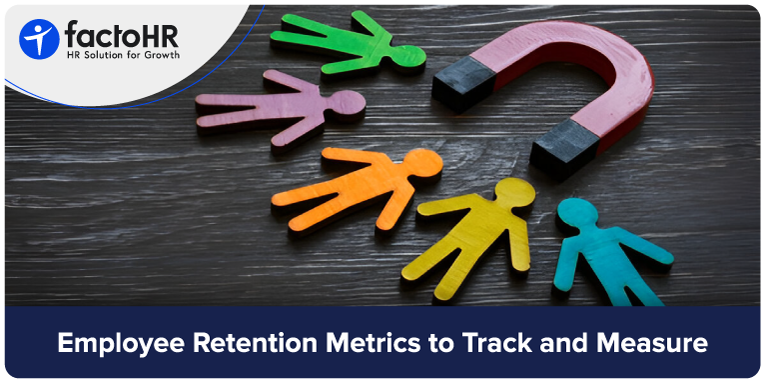10 Employee Retention Metrics You Need to Know

Table of Contents
Workers are the pillars of the success of your business. In an organization, create a workplace culture that makes employees feel appreciated, inspired, and committed to a common goal, allowing them to thrive and contribute their best work. But how well are your programs working in retaining staff for the long haul?
Analyze employee data to evaluate the effectiveness of your staff retention strategies and identify what works and what doesn’t. This will help you understand the employee experience and identify ways to improve the employee retention rate.
The employee retention metric rate in HR metrics is the number that organizations typically rely on to measure employee performance in terms of retaining people. Analysts often present these figures as ratios to enhance retention and compare them with the company’s targets. The result is that companies can measure employee satisfaction and determine the cause of staff turnover.

Why do You Need to Measure Employee Retention?
Knowing who is leaving and when they will do so will not provide insight into why people are leaving your organization. Calculating employee retention rate metrics reveals more than statistical figures. It helps you:
Evaluate Employee Satisfaction
Employee retention and satisfaction frequently correlate. Contented employees are less inclined to depart. Tracking retention metrics can help pinpoint challenges and enhance initiatives to increase employee satisfaction.
Understand Worker Dynamics
Monitoring the employee retention rate will let you know who is leaving, who is moving departments, who is going voluntarily, and who has been sent away.
Improve Your Retention Methods
The first step in creating an effective retention rate for HR strategy is to determine your turnover rates. Understanding retention metrics is crucial, as they provide valuable insights into employee-related statistics, enabling you to develop more effective retention strategies within the organization.
Save Money
The cost of replacing a leaving employee may be very high. Finding a suitable employee replacement is time-consuming and expensive. Additionally, the time spent searching for one may not be justified, as performance in the workplace may not be up to previous standards. This is due to the fact that not every employee possesses the same skills to perform the job.
How do You Measure Employee Retention?
Employee retention is essentially about how well a company can keep its team members on board over time—it’s a measure of who’s staying and who’s moving on. There are examples of employee retention metrics.
- Voluntary turnover indicates the number of employees who have left the firm. To calculate the voluntary turnover rate in an organization, get the total number of workers who have left the organization. Divide the total number of employees left by the total number of current employees within a given period by the average number. Then, multiply the value you got by 100. The result will be the final percentage.
- Retention rates refer to the proportion of employees who stayed with the firm. To calculate it, you will need to use this
Retention Rate formula: (existing employees – employees exiting) / initial number of employees x 100 - Voluntary versus involuntary turnover: Many businesses prefer to distinguish between employees who leave freely and those who are let go. This is the KPI for employee retention, used to analyze retention efforts and identify the causes of turnover.

Top 10 Employee Retention Metrics to Track and Measure

Tracking and measuring employee retention metrics is crucial in an organization. This improves organizational stability and helps comprehend workforce dynamics. Below is a comprehensive list of crucial metrics that businesses need to know.
Employee Retention Rate
Employee retention rate is considered one of the leading indicators for measuring employee retention in an organization. It generally measures a company’s capacity to retain its employees over time. A staff retention rate is deemed good if it exceeds 90%. It is critical to balance maintaining current employees and allowing new candidates to join the organization with more attractive skills and ideas.
Voluntary vs. Involuntary Turnover Rate
Voluntary turnover includes employees who leave for other companies, retire, or exit the workforce altogether. A low voluntary turnover rate means your workers are mostly satisfied with their work environment, work-life balance, and position. To calculate your voluntary employee turnover rate, divide the number of workers who left the organization voluntarily. This calculation should be performed over a specified period using data on the total number of workers in the firm.
Involuntary turnover is the number of employees your organization chooses to lay off or fire. The calculation is similar to the voluntary turnover rate: divide the number of employees laid off or dismissed by the total number of employees within a specific timeframe, then multiply by 100.
New Hire Retention Rate
The new employee turnover rate provides crucial information on how successfully you hire and integrate new staff. If you constantly lose your new hires after a couple of weeks, you are either not hiring the right people or your onboarding program is weak.
Maybe your hiring process is looking for the wrong talents, or your job descriptions do not represent the fundamental duties of the job. Remember that when employee turnover is high, it’s essential to reduce it as much as possible. Hiring an employee is costly and time-consuming; you won’t get a return on investment if they leave quickly.
Turnover Rate by Department or Manager
Assessing employee performance and retention rates offers important insights into a manager’s leadership skills. High retention rates typically indicate strong leadership, serving as a template for others to learn from and implement best practices. The turnover rate needs to be evaluated to know the success rate of retaining personnel at the management level. A low retention rate among managers in an organization may suggest that they are overwhelmed by their management duties. Maybe they do not have adequate tools to successfully carry out their routine tasks to meet the organizational needs. The loss of several managers will affect the workforce in the organization.
High-Performer Retention Rate
Knowing how successful you are at retaining your best personnel is also crucial. Your company will suffer if your total retention rate is strong but your turnover rate is high, particularly among your most skilled staff.
It also highlights a problem with career advancement opportunities and the risk of overworking top employees to the point of burnout. Assigning additional tasks to high-performing employees may lessen their motivation to exert greater organizational effort.
To calculate your retention rate, consider all employees, including top performers, as they collectively impact the overall retention rate calculation.
Employee Engagement Score
An employee’s involvement in the organization is a good predictor of whether or not he or she will stay with the organization. Engagement ratings may be obtained through various methods, including pulse and engagement surveys. A pulse survey is a series of brief questions conducted regularly to learn about people’s opinions about their workplace.
The combined responses to the pulse survey questions will enable the organization to evaluate whether its staff is engaged or disengaged. Another way to measure involvement is to ask questions in a survey. Surveys might be conducted periodically or yearly, depending on the organization’s culture.
Absenteeism Rate
Absenteeism is the number of employees absent from work due to illness, injury, personal leave, or unauthorized absence. The number is usually determined depending on the organization’s absenteeism policy. Turnover means the number of employees who voluntarily or involuntarily leave an organization. Examples include resignation, retirement, termination, or layoff.
To calculate such rates, divide the number of missing or leaving employees by the average number of employees in a specified period, such as a month, a quarter, or a year. The metrics and key performance indicators (KPIs) used for the calculation will be determined when calculating the absenteeism and turnover rates in the organization.
Average Employment Length
Calculating your average employee tenure will help you evaluate how effectively you provide a positive work environment with ample opportunities for growth. This indicator is usually computed by summing the total years worked by all your workers. Then divide the sum by the total number of employees in the organization.
For instance, if you have 200 workers who have worked for a total of 400 years, then the average period of employment is 2 years per employee.
Employee Satisfaction Rate
Another, more direct indicator of how employees feel about working for your organization is the percentage of pleased employees; content people are less likely to leave. The most straightforward approach to quantifying this is calculating your employee Net Promoter Score (eNPS), which is outlined below.
Anything above zero is considered acceptable. But to raise your retention rates, you’ll need to examine your employees’ satisfaction more closely. Promote a satisfaction-oriented culture by enhancing positive experiences and proactively addressing negative ones.
Cost of Turnover
Understanding employee retention is crucial for organizations due to the high costs associated with employee turnover. Data on various expenditures must be gathered to calculate these costs, including recruitment and training expenses for new hires. This key performance indicator (KPI) can be determined by calculating the average cost of hiring and onboarding a new employee. Additionally, it involves considering the expenses incurred during vacancy periods, such as temporary staffing or lost productivity. By tracking this metric, organizations can better grasp the financial implications of employee turnover and develop strategies to improve retention.

Conclusion
Calculating the employee retention rate allows you to understand the factors behind the numbers. They are the first step towards improving your retention strategy and retaining highly skilled workers. People analytics is a simple yet effective method for understanding real-time organizational changes.
A high staff retention rate suggests that most employees are satisfied. Employees satisfied with their current work environment are less likely to leave the company. Employee retention can also be improved by increasing salaries or offering additional professional development opportunities.
Organizations that want to reduce turnover, enhance employee satisfaction, and cultivate an exceptional team must monitor retention metrics. Understanding and using these employee retention metrics allows organizations to manage their workforces better and position themselves for success in today’s competitive business environment. You can use factoHR to learn about all the retention metrics.
Grow your business with factoHR today
Focus on the significant decision-making tasks, transfer all your common repetitive HR tasks to factoHR and see the things falling into their place.

© 2025 Copyright factoHR


